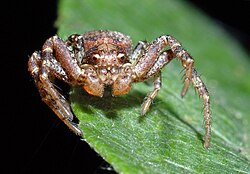Thomisidae
| Crab spiders | |
|---|---|

| |
| Ozyptila praticola | |
| Scientific classification | |
| Kingdom: | |
| Phylum: | |
| Class: | |
| Order: | |
| Superfamily: | |
| Family: | Thomisidae Sundevall, 1833
|
| Genera | |
|
Amyciaea | |
| Diversity | |
| 170 genera, > 2,000 species | |

| |
Crab spider is a common name applied loosely to many species of spiders, but most nearly consistently to members of the family Thomisidae. Among the Thomisidae it refers most often to the familiar species of "flower crab spiders", though not all members of the family are limited to ambush hunting in flowers.
Crab spider as a name in common use
Rationalisation for the name crab spider is generally subjective and anecdotal. It is commonly said to refer to a fancied resemblance to crabs, or to the way such spiders hold their two front pairs of legs, or their ability to scuttle sideways or backwards. Some spiders so called have bodies that are flattened and angular. At all events, the Thomisidae are the family most generally referred to as "crab spiders". However, some members of the Sparassidae are called giant crab spiders, Selenopidae are called wall crab spiders, and various members of the Sicariidae are sometimes called six-eyed crab spiders.[1] Some unrelated Orb-weaver spider species such as Gasteracantha cancriformis also are commonly called "crab spiders."
Such names are of little biological significance, and in this article the emphasis is on the Thomisidae.
Crab spider biology
None of the crab spiders mentioned build webs to trap prey, though all of them produce silk for drop lines and sundry reproductive purposes; some are wandering hunters and the most widely known are ambush predators. Some species sit on or beside flowers or fruit, where they grab visiting insects. Individuals of some species, such as Misumena vatia, are able to change color over a period of some days, to match the flower on which they are sitting. Some species frequent promising positions among leaves or bark, where they await prey, and some of them will sit in the open, where they are startlingly good mimics of bird droppings. However, note that these members of the family Thomisidae are not to be confused with the spiders that generally are called bird dropping spiders, not all of which are close relatives of crab spiders.
Other species of crab spiders with flattened bodies, either hunt in the crevices of tree trunks or under loose bark, or shelter under such crevices by day, and come out at night to hunt. Members of the genus Xysticus hunt in the leaf litter on the ground. In each case, crab spiders use their powerful front legs to grab and hold onto prey while paralyzing it with a venomous bite.
The spider family Aphantochilidae was incorporated into the Thomisidae in the late 1980s. Aphantochilus species mimic Cephalotes ants, on which they prey.
The spiders of Thomisidae are not known to be harmful to humans. However, spiders of an unrelated genus, Sicarius, which are sometimes referred to as "crab spiders", or "six-eyed crab spiders", are close cousins to the recluse spiders, and are highly venomous, though human bites are rare.






Systematics

The following subfamilies are recognized:
- Aphantochilinae (3 genera)
- Bominae Ono, 1984 (9 genera)
- Dietinae (32 genera)
- Stephanopinae (35 genera)
- Stiphropodinae (3 genera)
- Strophiinae (8 genera)
- Thomisinae (67 genera)
- incertae sedis
- Ansiea Lehtinen,
- Carcinarachne Schmidt, 1956
- Cozyptila Lehtinen & Marusik, 2005
- Ebelingia Lehtinen, 2005
- Facundia Petrunkevitch, 1942 † (fossil)
- Fiducia Petrunkevitch, 1942 † (fossil)
- Henriksenia Lehtinen, 2005
- Hexommulocymus Caporiacco, 1955
- Ledouxia Lehtinen, 2005
- Mastira Thorell, 1891
- Megapyge Caporiacco, 1947
- Modysticus Gertsch, 1953
- Rejanellus Lise, 2005
- Syphax Koch & Berendt, 1854 † (fossil)
- Tarrocanus Simon, 1895
- Taypaliito Barrion & Litsinger, 1995

See also
References
- ^ Filmer, Martin (1997). Southern African Spiders. City: BHB International / Struik. ISBN 1-86825-188-8.
- Biolib family Thomisidae
- Lise, A.A. (2005). Rejanellus, a new genus of Thomisidae (Araneae, Stephanopinae). Iheringia, Sér. Zool. 95(2):151-164. PDF
External links
- Crab Spider Misumenoides formocipes diagnostic photos
- Crab Spider Xysticus sp. photos and information
- Tmarus angulatus guarding her eggs
- Picture of Amyciaea albomaculata
- Pictures and text of crab spiders
- Photos of American Crab Spiders
- Photos and Info on Australian Crab Spiders
- Kentucky Crab Spiders Photos and Information
- Picture of Stephanopis championi
- Pictures of crab spiders (free for noncommercial use)
- Photoshooting with a white crab spider[dead link]
